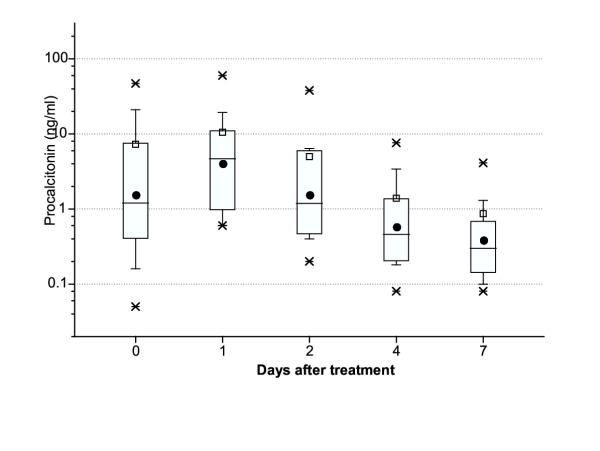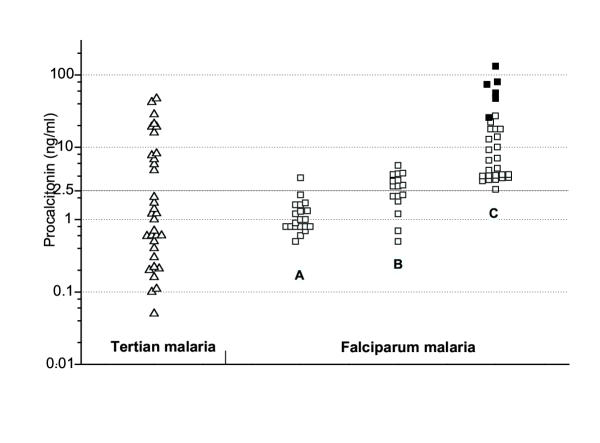Abstract
Background
Procalcitonin (PCT) is closely correlated with parasite burden and clinical outcome in falciparum malaria. The role of PCT in tertian malaria has not previously been investigated.
Patients and methods
PCT serum levels in 37 patients with tertian malaria were analysed. Clinical and laboratory parameters were assessed and statistically correlated both to the initial PCT levels and during the course of the disease.
Results
PCT levels rose for one day after commencing treatment and declined thereafter. However, there was no significant correlation with parasite burden, clinical parameters, laboratory values, or the presence of semi-immunity. Before treatment, the majority of patients showed normal or slightly elevated PCT levels (< 2.5 ng/ml), but PCT was markedly elevated (4.8 – 47 ng/ml) in one third of the population. The two groups did not differ by any other of the assessed parameters. Thus, while the post-treatment course of PCT resembles falciparum malaria, the lack of correlation between disease severity and even high PCT levels in a large proportion of patients is intriguing.
Conclusions
There is a fundamental difference in the relationship of PCT with tertian malaria not seen in other infectious diseases in which elevated PCT levels have been observed. This suggests distinct pathophysiological pathways in malaria.
Background
Procalcitonin (PCT) is elevated in serum of patients with severe infections of bacterial or parasitic origin [1]. Increased levels have also been described in falciparum malaria [2-6]. It has been recently demonstrated that PCT levels in falciparum malaria correlate with parasitemia and disease severity, and that markedly elevated values (> 25 ng/ml) are associated with a high risk of fatal outcome [5]. In this study, PCT levels were investigated in patients with tertian malaria, which is generally mild without severe organ complications and which is usually non-fatal.
Patients and methods
Patients with malaria who are seen at the site of the study follow a standard protocol for prospective assessment of relevant parameters. Thirty seven unselected, consecutive patients with tertian malaria due to Plasmodium vivax or Plasmodium ovale seen during 2000 and 2001 and in whom all necessary data were available, were analysed. Concomitant infections with a possible impact on PCT levels were excluded by history, clinical examination, and laboratory tests. Patients who were raised in an area endemic for tertian malaria were defined as semi-immune (n = 12). Blood samples were drawn immediately before treatment (day 0) and on follow-up until day 7. Some of the samples were stored at -80°C until analysis. PCT serum levels were determined using an immuno-luminometric assay (LUMItest PCT, BRAHMS Diagnostica GmbH, Berlin, Germany) according to the manufacturer's specifications. Routine laboratory investigations included differential blood count, haemoglobin, platelets, standard coagulation tests, creatinine, neopterin, C-reactive protein, lactate dehydrogenase and liver function tests. Patients were monitored by physical examination, ECG, abdominal ultrasound, and chest radiography. All but two patients received chloroquine for treatment. Two patients, in whom the plasmodium species could not be differentiated by the first blood sample, received mefloquine. Results were compared with data obtained at the same site in a cohort of Plasmodium falciparum patients and published earlier [5].
Results
The median reported duration of illness before diagnosis was 3.5 days. All patients had a low or modest parasitemia (< 1%), haemoglobin concentrations >12 g/dl (except two patients with 8.4 and 10.7 g/dl), normal renal and liver function, and no signs of concomitant infections. The disease progression was always mild with a rapid parasite clearance in response to anti-malarial treatment. None of the patients had fever after day three. Initial PCT concentrations varied between < 0.1 ng/ml and 47 ng/ml and, in all patients, dropped with declining parasite counts and clinical recovery (Figure 1). Only few patients had slightly elevated PCT levels after complete parasite clearance. PCT levels before treatment did not correlate with parasite burden, laboratory values, reported duration of illness, body temperature or fever attacks, or the presence of semi-immunity. Before treatment, two thirds of the patients showed normal (< 0.5 ng/ml) or slightly elevated PCT levels (geometric mean 0.44 ng/ml, range < 0.1 – 2.1). In a subset of patients (12/37), however, PCT was markedly elevated (geometric mean 14.4 ng/ml; range 4.8 – 47). PCT in these patients was in the range of patients with severe and complicated falciparum malaria (> 2.5 ng/ml, Figure 2). The two groups with low or high PCT were undistinguishable by means of history, clinical signs, or laboratory parameters. In particular, secondary infections or other possibly explanatory conditions could not be identified.
Figure 1.
Serum procalcitonin (PCT) concentrations in 37 patients with tertian malaria immediately before treatment (day 0), and on follow-up. Box: median, 25th, and 75th percentile; whiskers: 5th and 95th percentile; star: 1st and 99th percentile; open squares: mean; filled circles: geometric mean.
Figure 2.
PCT levels before treatment in patients with tertian malaria (triangles) compared to falciparum malaria (open squares: survivors; filled squares: patients that died). Cluster A: semi-immune patients; cluster B: non-immune patients with mild disease; cluster C: non-immune patients with severe and complicated disease. The horizontal line at 2.5 ng/ml is the lower cut-off for complicated falciparum malaria and arbitrarily discriminates a high level from a low level group in tertian malaria. Falciparum malaria data originate from another study).)[5].
Discussion
In contrast to falciparum malaria and other infectious diseases in which PCT is induced, markedly elevated PCT levels could be observed in this cohort in one third of the patients without any correlation to disease severity. This could not be attributed to concomitant infections or complications. While the study was not statistically powered to significantly detect weak correlations, the large number of patients with high PCT levels is intriguing. Although the pathophysiology of PCT has not been determined yet, the question remains, what is so different in tertian malaria. In contrast to bacterial or other infectious diseases, tertian malaria is characterized by surges in parasitic density and fever every 48 hours, leaving time in-between for the defence system to recover. The magnitude of PCT induction may also depend on host factors. It would be interesting to find out whether such host factors indicated an individual risk of developing severe falciparum malaria.
Conclusions
The unique feature of PCT induction in tertian malaria raises interesting questions about the clinical and pathophysiological role of PCT in infectious diseases and in malaria in particular. This should stimulate further research on PCT and malaria pathophysiology.
Authors' contributions
CM conceived the study and participated in the statistical analysis. SS assessed the clinical parameters and participated in the design of the study and the statistical analysis. CC performed the PCT measurements and recruited the patients. MD participated in the conception and design of the study.
Contributor Information
Christoph Manegold, Email: manegold@bni.uni-hamburg.de.
Stefan Schmiedel, Email: stefanschmiedel@aol.com.
Collins B Chiwakata, Email: chiwa.family@t-online.de.
Manfred Dietrich, Email: dietrich@bni.uni-hamburg.de.
References
- Assicot M, Gendrel D, Carsin H, Raymond J, Guilbaud J, Bohuon C. High serum procalcitonin concentrations in patients with sepsis and infection. Lancet. 1993;341:515–518. doi: 10.1016/0140-6736(93)90277-N. [DOI] [PMC free article] [PubMed] [Google Scholar]
- Al-Nawas B, Shah P. Procalcitonin in acute malaria. Eur J Med Res. 1997;2:206–208. [PubMed] [Google Scholar]
- Davis TM, Assicot M, Bohuon C, St John A, Li GQ, Anh TK. Serum procalcitonin concentrations in acute malaria. Trans R Soc Trop Med Hyg. 1994;88:670–671. doi: 10.1016/0035-9203(94)90221-6. [DOI] [PubMed] [Google Scholar]
- Hollenstein U, Looareesuwan S, Aichelburg A, Thalhammer F, Stoiser B, Amradee S, Chullawichit S, El M, Burgmann IH. Serum procalcitonin levels in severe Plasmodium falciparum malaria. Am J Trop Med Hyg. 1998;59:860–863. doi: 10.4269/ajtmh.1998.59.860. [DOI] [PubMed] [Google Scholar]
- Chiwakata CB, Manegold C, Bonicke L, Waase I, Julch C, Dietrich M. Procalcitonin as a parameter of disease severity and risk of mortality in patients with Plasmodium falciparum malaria. J Infect Dis. 2001;183:1161–1164. doi: 10.1086/319283. [DOI] [PubMed] [Google Scholar]
- Richard-Lenoble D, Duong TH, Ferrer A, Lacombe C, Assicot M, Gendrel D, Bohuon C, Kombila M. Changes in procalcitonin and interleukin 6 levels among treated African patients with different clinical forms of malaria. Trans R Soc Trop Med Hyg. 1997;91:305–306. doi: 10.1016/s0035-9203(97)90086-9. [DOI] [PubMed] [Google Scholar]




